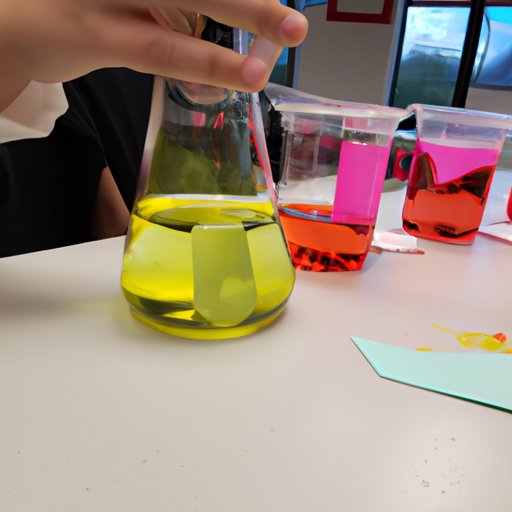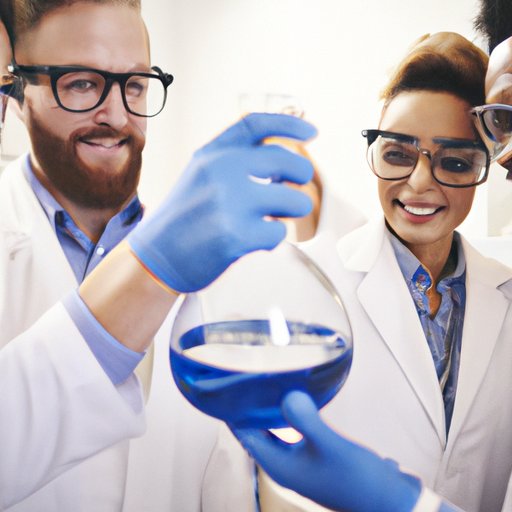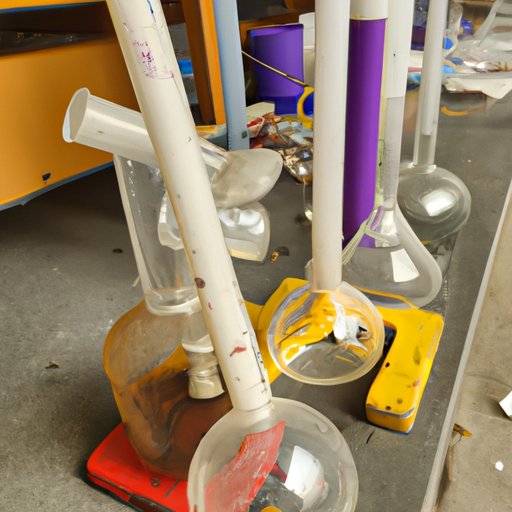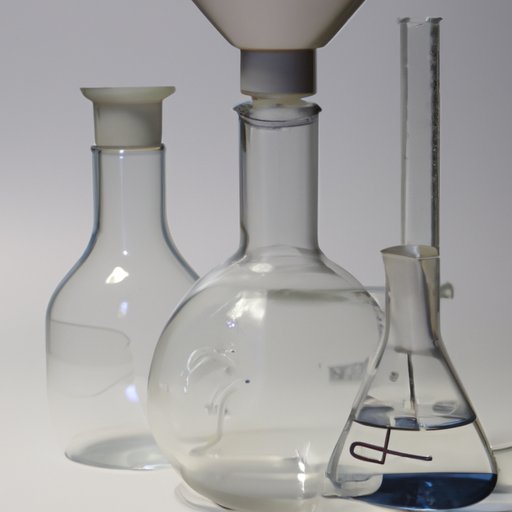Introduction
A flask is a type of container used to hold and store liquids or other substances. The shape of the flask can vary depending on the purpose, but they usually have a narrow neck and wide body. Flasks are commonly used in laboratory settings, where they are essential for many scientific experiments and procedures. In this article, we will explore what flasks are used for in science and how they benefit scientific research.

Exploring the Different Applications of Flasks in Science
Flasks are used in science for a variety of purposes. Some of the most common applications include measurement, storage, mixing and separating, heating and cooling, and more. Let’s take a closer look at each of these applications:
Measurement
Flasks are often used to measure the volume of a liquid or other substance. They are typically marked with graduations that allow for accurate measurements. Flasks with volumetric markings are called “volumetric flasks” and are often used in titration experiments.
Storage
Flasks can also be used for storage. They are ideal for storing samples or solutions, as the shape of the flask helps prevent spills or contamination. Flasks are typically made from glass or plastic, which makes them easy to clean and sterilize.
Mixing and Separating
Flasks can be used to mix two or more substances together, or to separate one substance from another. This is especially useful in chemical reactions, where precise amounts of chemicals need to be combined in order to achieve the desired result.
Heating and Cooling
Flasks are often used in experiments that require heating or cooling. They are able to withstand extreme temperatures, making them ideal for experiments involving boiling, distilling, or freezing.
Understanding the Basics of Flasks and Their Uses in Science
Before using a flask in a science experiment, it is important to understand the basics of flasks and how they are used in science. First, let’s look at the different types of materials that flasks can be made from:
Types of Flask Materials
Flasks can be made from a variety of materials, including glass, plastic, and metal. Glass is the most common material used for flasks, as it is durable and does not react with chemicals. Plastic flasks are also popular, as they are lightweight and less prone to breakage than glass. Metal flasks are mainly used for storing volatile liquids, such as acids or bases.
Flask Sizes and Shapes
Flasks come in a range of sizes and shapes. The size of the flask depends on the amount of liquid or substance it is intended to hold. The shape of the flask also varies depending on its purpose. For example, Erlenmeyer flasks are conical in shape, while Florence flasks are round-bottomed and have a long neck.
A Comprehensive Guide to Using Flasks in Science Experiments
When performing a science experiment that requires the use of a flask, there are several steps you should follow to ensure accuracy and safety. Here is a comprehensive guide to using flasks in science experiments:
Preparing the Flask
Before beginning the experiment, you should prepare the flask by cleaning it thoroughly. If you are using a glass flask, you should also check for any cracks or chips that may affect the accuracy of the experiment. Once the flask is clean and free from damage, it should be ready for use.
Performing the Experiment
When performing the experiment, make sure to follow all safety guidelines and instructions. Be sure to wear protective clothing and goggles to protect yourself from any hazardous materials. Also, make sure to use the correct amount of each substance and to record all measurements accurately.
Cleaning and Storing the Flask
After the experiment is complete, you should thoroughly clean the flask and store it in a safe place. This will help to prevent contamination and keep the flask in good condition for future use.

Examining the Benefits of Using Flasks in Scientific Research
Using flasks in scientific research offers a number of benefits. Here are some of the key benefits of using flasks in scientific experiments:
Accuracy
Flasks are designed to be accurate and precise, making them ideal for measuring and storing substances. This helps to ensure that the results of the experiment are reliable and reproducible.
Safety
Flasks are designed to be safe and durable, which reduces the risk of accidents or contamination. Glass flasks are particularly safe, as they are less likely to break or shatter than plastic or metal flasks.
Cost-Effectiveness
Flasks are relatively inexpensive and can be reused multiple times. This makes them a cost-effective option for many scientific experiments.

How Flasks are Used for Measurement and Storage in Science
Now that we’ve discussed the benefits of using flasks in science, let’s take a look at how flasks are used for measurement and storage in science.
Measuring Volumes
Flasks are commonly used to measure the volume of a liquid or other substance. This is done by filling the flask with the substance and then using the graduations on the flask to measure the amount. Volumetric flasks are particularly useful for this purpose, as they are designed to be extremely accurate.
Storing Samples
Flasks are also used to store samples or solutions. The shape of the flask helps to prevent spills and contamination, making it ideal for storing hazardous materials. Additionally, flasks are easy to clean and sterilize, making them perfect for storing biological samples.
An Overview of the Different Types of Flasks Used in Science
Now that we’ve covered the basics of flasks and their uses in science, let’s take a look at some of the different types of flasks used in science:
Erlenmeyer Flasks
Erlenmeyer flasks are conical in shape and have a narrow neck. They are often used for measuring, mixing, and storing substances. They are also frequently used in titration experiments.
Florence Flasks
Florence flasks are round-bottomed and have a long neck. They are commonly used for distillation and boiling experiments. They are also used for storing and measuring liquids.
Volumetric Flasks
Volumetric flasks are designed to be extremely accurate and are used to measure the volume of a liquid. They are usually made from glass and have volumetric markings on the side.
Beakers
Beakers are cylindrical in shape and are often used for mixing and measuring substances. They are usually made from glass and come in a range of sizes.
Test Tubes
Test tubes are small tubes that are used to hold and store small amounts of substances. They are commonly used for mixing, storing, and transporting samples.
Graduated Cylinders
Graduated cylinders are tall, cylindrical containers that are used for measuring volumes. They are typically made from glass or plastic and have graduations on the side.
Distilling Flasks
Distilling flasks are specialized flasks that are used in distillation experiments. They are usually made from glass and have a wide mouth and a narrow neck.
Conclusion
Flasks are essential tools in many scientific experiments and procedures. They are used for a variety of purposes, including measurement, storage, mixing and separating, heating and cooling, and more. Understanding the basics of flasks and their uses in science is key to ensuring accurate and safe results. As we have seen, flasks offer many benefits, including accuracy, safety, and cost-effectiveness. By following the comprehensive guide outlined in this article, you can ensure that your experiments are successful and your results are reliable.
(Note: Is this article not meeting your expectations? Do you have knowledge or insights to share? Unlock new opportunities and expand your reach by joining our authors team. Click Registration to join us and share your expertise with our readers.)
